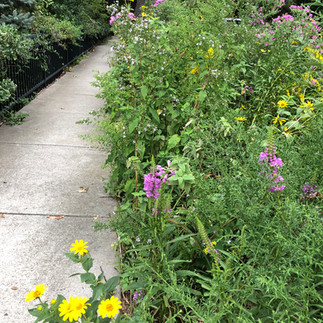Native Plant Gardens: Too Wild?
- Nuts for Natives
- Sep 20, 2023
- 3 min read
Updated: Sep 25, 2023
What changes: the garden or our aesthetics.

I think a lot about how to get people excited about having a different type of garden - one with native plants. A few weeks ago, I stayed in a rental house with a shared driveway. The homes on either side of the driveway had the exact same layout -- a slope from the main road down to the homes and a grassy area between the homes and a lake. Identical lots but the landscaping could not have been more different.
I have no idea what motivated the planting of the meadow, the age of it or the maintenance practices. I do know the feel from one side to the other was night and day.
In this situation, a meadow makes complete sense. The slope is steep enough that I would guess it is largely unused and turning the lawn to meadow is an ecological and aesthetic win. In smaller spaces though, could too much wildness perpetuate the myth that native plant gardens have to be wild looking?

I ponder this with a 15 foot stretch of tree lawn I planted with native perennials 5 years ago. This area between our sidewalk and street is in full sun and one of the few full sun areas we have. The area was planted with amsonia (Amsonia tabernaemontana), asters (Symphyotrichum laeve), bee balm (Monarda fistulosa), blue hyssop (Agastache foeniculum), coneflowers (Echinacea purpurea), swamp sunflower (Helianthus angustifolius), phlox (Phlox paniculata), goldenrod (Solidago rugosa) and a few non-native daylilies (Hemerocallis). At first, everything was neat and tidy.

A couple of years in, one or two perennials (sunflowers and goldenrods) tried to take over the others. With some editing, they seemed to reach equilibrium. For the past two years, all I have done is cut back wayward stems that fall into the sidewalk or street. That is a must. Passersby definitely don't want to have to move plants to use public spaces.
I now realize through most of the summer, there is more foliage than flowers. Could this wild look discourage others from thinking about adding native plants to their gardens? Quite possibly.

The Fixes:
Meticulous Maintenance
The reality is I don't get to the straggling branches leaning over the sidewalk as soon as they happen. I should make this an every other day quick check. Also, further in from this planting, beneath a red oak, there is a section of tree lawn where an earlier planting of Pennsylvania sedge died. The dry conditions, foot traffic and pet visits were just too much for the plug sized plants. While a few perennials self seeded in this space, so did weeds. At a minimum, this should be weeded and mulched. While bugs love messiness, our species generally does not and my goal is to make these native plants attractive!

Grouping Perennials
Following the example of the meadow, longer term, I could remove the perennials and replant in clumps of the same species. Grouping the same flowers would create blocks of color giving the area a more planned look and making flowers easier to see. While we may plant in groups, mother nature will have the final say. Hard to say whether this meadow will still look like this several years down the road.
Reduce Number of Species
Likewise, reducing the number of species to three or four would help it look a little more tame and more consistent. The trick would be to make sure to have succession of bloom so perhaps amsonia, bee balm, coneflower, asters and goldenrod. That's five and therein lies the challenge!
Please let me know what you would do! In the meantime, I'm going to work on that maintenance and leave up those seed heads for the wintering over birds.
Happy Gardening.









































Comments